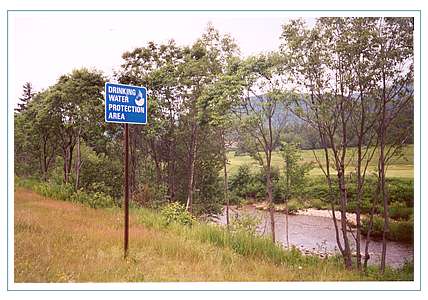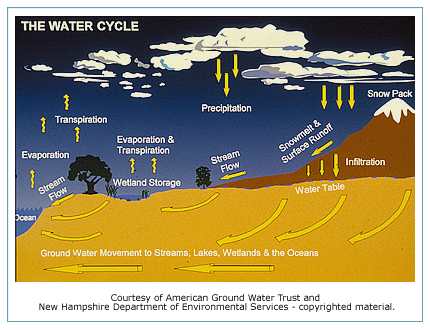Water Conservation Quiz
- Where does drinking water come from in New England?
- How is drinking water used in most communities?
- Is ground water only important to people?
- Can ground water withdrawals affect other natural resources?
- Are rivers and streams being affected from increased water withdrawals?
- Is the amount of water which is available on earth lessening?
- Are there opportunities to lessen the amount of water we use for drinking water, cleaning, irrigation, etc.?
Where does drinking water come from in New England?
In New England, ground water and surface waters (reservoirs, lakes and rivers) are sources of drinking water for homes and businesses. If you don’t have your own private well, you can call your water supplier to learn the source(s) of your drinking water or read the annual water quality report available from your water supplier.

How is drinking water used in most communities?
Drinking water is used for many purposes, including residential uses, industrial uses, business uses, and agricultural uses. Residential uses may include drinking, bathing, cooking, cleaning and personal care, lawn and garden watering, and recreation. Per capita (per person) use of public water supplies in the United States in 1990 averaged 183 gallons per day (gal/d).
Is ground water only important to people?
In addition to its use by people, ground water flows into wetlands, rivers, streams, ponds, lakes, and estuaries in our region, ensuring they have adequate water to maintain the soil conditions, plants and animal life which live there. This is why most streams in New England maintain water flow during the dry summer months when there is little rain to sustain these waters.
Can ground water withdrawals affect other natural resources?
Ground water is withdrawn by installing wells, and is used for drinking water, irrigation, manufacturing, and other purposes. When precipitation reaches the land surface, some seeps into ground water, causing its level to raise. During a period of drought the ground water isn’t adequately replenished and its level lowers. Ground water levels are also lowered in areas where the demand for ground water to provide drinking water or irrigation exceeds the amount of precipitation (ex. rainfall, snow melt) which can reach and replenish it. When the ground water level lowers, it may lessen ground water discharging to streams, lakes and ponds, causing surface water levels to lower too. As the supply of ground water lessens, there is less water available for drinking water, and ground water can no longer adequately sustain the lakes, ponds, rivers, streams and wetlands nearby.

Are rivers and streams being affected from increased water withdrawals?
Increased water demand is affecting many rivers and streams in our region. For example, the Ipswich River Basin supplies water to about 330,000 Massachusetts residents in 23 municipalities. In the summers of 1995, 1997 and again in 1999, much of the upper Ipswich River dried up, resulting in fish kills and the destruction of critical aquatic and wetland habitat areas. These problems were caused by a combination of prolonged dry weather and water withdrawals by communities using the Ipswich River basin as a source of water supply. Problems such as this, are unfortunately, no longer unique.
Is the amount of water which is available on earth lessening?
The water available on earth isn’t changing. Water travels on a never-ending journey between earth and sky. We call this journey the water cycle. Water falls to the ground through rain, sleet ice and snow. Once on the earth, some of that water seeps through soil or bedrock and becomes ground water. The ground water may be withdrawn to provide drinking water or to support industry and agriculture, or it may flow into lakes, streams, rivers wetlands, and estuaries. Some water runs off the land surface and enters directly into lakes and streams. And, some water evaporates or is used by plants and transpired into the atmosphere. Once water vapor is released to the atmosphere, water condenses and becomes part of a cloud foundation. In time, it falls back to the earth again. The amount of water available to us doesn’t change as the cycle repeats over and over again. But, people’s demand for increasing amounts of water may lessen the availability of water to meet our needs.
Are there opportunities to lessen the amount of water we use for drinking water, cleaning, irrigation, etc.?
Yes, read on to find out more about how water conservation can save you money, while also helping to maintain New England’s drinking water supplies and other natural resources.
